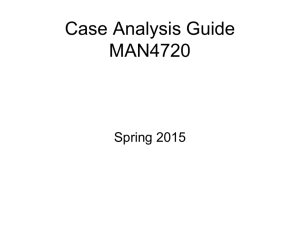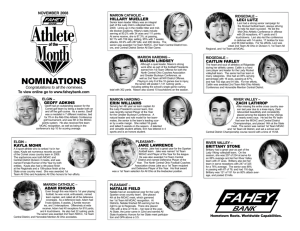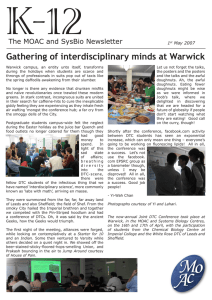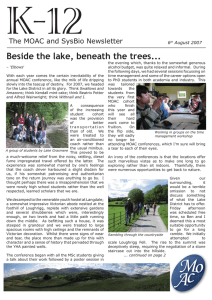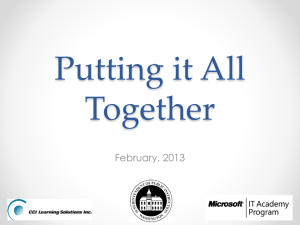K-12 Sun, Sand and... Seminars! The MOAC Newsletter 9
advertisement
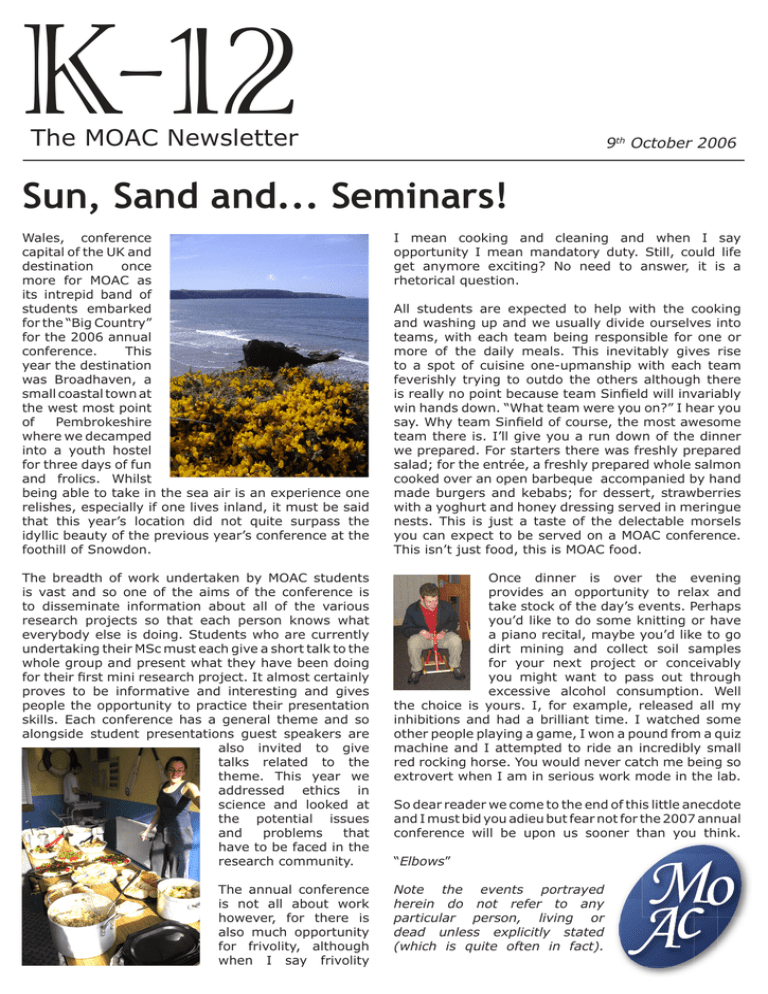
K-12 The MOAC Newsletter 9th October 2006 Sun, Sand and... Seminars! Wales, conference capital of the UK and destination once more for MOAC as its intrepid band of students embarked for the “Big Country” for the 2006 annual conference. This year the destination was Broadhaven, a small coastal town at the west most point of Pembrokeshire where we decamped into a youth hostel for three days of fun and frolics. Whilst being able to take in the sea air is an experience one relishes, especially if one lives inland, it must be said that this year’s location did not quite surpass the idyllic beauty of the previous year’s conference at the foothill of Snowdon. I mean cooking and cleaning and when I say opportunity I mean mandatory duty. Still, could life get anymore exciting? No need to answer, it is a rhetorical question. The breadth of work undertaken by MOAC students is vast and so one of the aims of the conference is to disseminate information about all of the various research projects so that each person knows what everybody else is doing. Students who are currently undertaking their MSc must each give a short talk to the whole group and present what they have been doing for their first mini research project. It almost certainly proves to be informative and interesting and gives people the opportunity to practice their presentation skills. Each conference has a general theme and so alongside student presentations guest speakers are also invited to give talks related to the theme. This year we addressed ethics in science and looked at the potential issues and problems that have to be faced in the research community. Once dinner is over the evening provides an opportunity to relax and take stock of the day’s events. Perhaps you’d like to do some knitting or have a piano recital, maybe you’d like to go dirt mining and collect soil samples for your next project or conceivably you might want to pass out through excessive alcohol consumption. Well the choice is yours. I, for example, released all my inhibitions and had a brilliant time. I watched some other people playing a game, I won a pound from a quiz machine and I attempted to ride an incredibly small red rocking horse. You would never catch me being so extrovert when I am in serious work mode in the lab. The annual conference is not all about work however, for there is also much opportunity for frivolity, although when I say frivolity All students are expected to help with the cooking and washing up and we usually divide ourselves into teams, with each team being responsible for one or more of the daily meals. This inevitably gives rise to a spot of cuisine one-upmanship with each team feverishly trying to outdo the others although there is really no point because team Sinfield will invariably win hands down. “What team were you on?” I hear you say. Why team Sinfield of course, the most awesome team there is. I’ll give you a run down of the dinner we prepared. For starters there was freshly prepared salad; for the entrée, a freshly prepared whole salmon cooked over an open barbeque accompanied by hand made burgers and kebabs; for dessert, strawberries with a yoghurt and honey dressing served in meringue nests. This is just a taste of the delectable morsels you can expect to be served on a MOAC conference. This isn’t just food, this is MOAC food. So dear reader we come to the end of this little anecdote and I must bid you adieu but fear not for the 2007 annual conference will be upon us sooner than you think. “Elbows” Note the events portrayed herein do not refer to any particular person, living or dead unless explicitly stated (which is quite often in fact). 2 Editorial The back rooms of engineering are but a distant memory as we look around today and appreciate the current extent of MOAC. Albeit, with expansion comes distance and what better way to bridge this gap than a newsletter. This first edition provides an introduction to MOAC, its members and hopefully, its atmosphere. I am also hoping that it will inspire the more adventurous amongst you to contribute to future editions. Now, let me explain our title; our first challenge, solved by an open competition. It was won by Richard for the obscure relevance of his suggestion, K12; moaC being a gene in the K12 strain of E. Coli. Every member of MOAC is familiar with said bacteria in one way or another and we thought it was about time we embraced our inner geek. Having mentioned ‘we’, I must thank everyone involved in this endeavour from the contributors to the MOAC admin and, most importantly, Gemma and Yi for all their editorial help. - Lahari de Alwis Who’s Who of the MOAC Offices – Dorothea Mangels Alex Baciu and Sophy Kant have been with us over the summer and have done a smashing job dealing with applications, organising everyone’s advisory committee meetings, organising special events like Ann Dixon’s BCG meeting and Alison Rodger’s CD Summer School and getting MOAC’s database up to scratch. Sophy has just finished her Masters in English Literature and Alex is continuing her training at the Warwick Medical School. Unfortunately, both of them will leave us in the next couple of weeks – Sophy to try and find a “proper” job and Alex to devote all her energy to her course. Good Luck to both of you!!! Monica Lucena has recently joined MOAC and the new Systems Biology DTC as our Postgraduate Taught Course Co-Ordinator. She’ll look after MOAC’s and Systems Biology’s MSc students, organise timetables, liaise with lecturers and mini project supervisors. She’ll also handle new applications for next year’s intake. Monica is a trained Chemist. Before she joined MOAC, she has lived in Portugal, Italy, the US and the Netherlands. As a result of all this globetrotting, Monica speaks 5 languages. Dorothea Mangels will continue to look after the rest of MOAC’s and Systems Biology’s admin needs. Amongst other things, she’ll hassle everyone regarding advisory committee meetings, look after the budgets and the premises, liaise with contributing Science Departments and with University House offices. Dorothea has lived in Bremen (Germany), Glasgow and Warwick. She has a PhD in Plant Biochemistry and used to be a post-doctoral researcher L—R: Alex, Monica, Sophy and Dorothea in Colin Robinson’s lab at Warwick working on the protein transport machinery in bacteria. Together, we hope to make everyone’s (including Alison’s and Colin’s) time in MOAC and Systems Biology as pleasant and productive as possible. Letters to the editor No student newsletter would be complete without a section dedicated to the students themselves to air their views on anything and everything, so here it is. Today, Richard has provided us with his thoughts on homeopathy. You are welcome to reply with any of your own. If you have a topic to discuss, please email your letter (in 500 words or less) to editormoac@googlemail.com. Homeopathic medicine or expensive water? New regulations have just come into force governing the marketing of homeopathic medicines. The British Homeopathic Association and Faculty of Homeopathy welcome this change. John Saxton, President of the Faculty of Homeopathy, says in a press release: “The inclusion of therapeutic indications on the labels of overthe-counter homeopathic medicines will make homeopathy more accessible to the public, allowing people to select remedies for minor acute, self-limiting ailments such as nausea, headache, skin conditions and digestive complaints. This is a step in the right direction for those who believe in the importance of patient choice.” http://www.trusthomeopathy.org/csArticles/articles/000001/000104.htm The Medicines and Healthcare Regulatory Agency, which is responsible for the change, has issued a similarly upbeat press release. Sense About Science takes a different view. Their briefing begins: “Homeopathy is marketed as a safe, natural and holistic treatment for a range of ailments and illnesses… Homeopathic products and services have become a large industry. Despite this, it has not been embraced by medical science. The scientific evidence shows that homeopathy acts only as a placebo and there is no scientific explanation of how it could work any other way.” http://www.senseaboutscience.org.uk/index.php/site/project/86 While there is anecdotal evidence that homeopathic treatment can be helpful and doubt has been cast on the independence of some clinical trials, it is surely sensible to legally require that all claims to therapeutic efficacy be properly substantiated. The new regulations make an exception to this principle for homeopathic products. Since when is lack of information a good basis for patient choice? See the Sense About Science website for a 2 page statement of objection which you might like to sign. Richard Wilson 3 New MSc Students & their fields of expertise SYSTEMS BIO MOAC Barry Silver Horticulture Hashem Koohy Mathematics Emma Cooke Mathematics Howard Lightfoot Bioinformatics Andrew McCarthy Biochemistry Dominic Lawrance Biochemistry Edward Morrisey Physics Emma Picot Biochemistry James Stephenson Bioinformatics & Genetics Jie Chu Biotechnology George Efstathiou Informatics John Dickson Physics Liam Jones Mathematics Lucas Wilkins Chemistry Marc Rossello Bioinformatics Stuart McHattie Naveed Malik Spyros Charonis Natural Sciences & Physics Computational Biology Bioinformatics & Zoology Homing Lai Comp. Science and Applied Maths 4 Current PhD Students 1st Year Daniel Bearup – We aim to construct a mathematical model of the cytoplasmic phase of peptidoglycan biosynthesis. We will use absorbance and fluorescence spectroscopy assays to determine kinetic mechanisms and constants. The pathway will also be constructed in vitro. Ultimately we hope to use this to improve drug design by finding efficient ways to inhibit the pathway. Hayley Morley – I’ll be studying a number of biological processes using a hybrid technique involving Evanescent Wave Cavity Ring-Down Spectroscopy and Scanning Electrochemical Microscopy. These processes include the lateral diffusion of protons across lipid bilayers, diffusion of ions within bilayers and the early stages of amyloid fibrillization in prion diseases such as Parkinson’s and Alzheimer’s. Jonathan Armond – It is predicted that microtubules directly generate the force which separates the chromosomes during mitosis and I will investigate this model using atomic force microscopy to obtain measurements. We will also be mathematically modelling this system and creating computational stochastic simulations of the depolymerisation of microtubules. I will also be using linear dichroism, electrochemical methods, confocal microscopy and cloning. Alistair Irvine – I aim to understand the structures and properties of protein folding intermediates and how the process of folding is facilitated by molecular catalysts. I will be using solution state NMR, mass spectrometry and computational methods, such as molecular dynamics. Jing Kang (Jasmine) – My research involves constructing the learning model, simulating neuron spiking behaviour by finding their connection weight in a system and applying the method to experimental data. I am also interested in the study of how neurons store and retrieve information. Further work will concentrate on a single neuron and the corresponding metabolic change inside it. Elina Vladimirou – My PhD involves investigating the structure and function of the endocytic protein, auxilin. CD, FTIR and NMR will be used to probe its structural properties. Auxilin fragments and mutants will be constructed and investigated using time-resolved fluorescence anisotropy and analytical centrifugation. Bioinformatics tools will be developed and used to create a theoretical model. Paul Garner – I aim to further understand the assembly of the twin arginine translocation ABC protein complex in bacteria by running computer simulations of protein aggregation in the membrane. 2nd Year Abdnacer Bouchekhima (Nacer) – The aim of my work is to characterise the Endoplasmic Reticulum in plants and find the transport rates and routes of the secretory pathway in an interplay between confocal imaging, photo-activation experiments, image processing techniques, 3D reconstruction and visualisation software packages together with mathematical modelling of the transport equation. Gemma Warren –The original aim of my project was to look at protein transport in the cyanobacterium Synechocystis PCC 6803, using confocal laser scanning microscopy (CLSM). I have spent my first year tagging proteins with green fluorescent protein in vivo and imaging the cells using CLSM to determine protein localisation. James Lister Sinfield – Former ironmonger, theoretical physicist, bomb disposer and rocket scientist. Now working on a project to build a brain. Using mathematical modelling techniques I am building simplified models of the cortex to investigate how learning occurs and how memories are stored and retrieved. I also like gravy and hats. Martyn Rittman – Originally trained as a mathematician and physicist, I now find myself with supervisors in chemistry and statistics, studying linear dichroism - the most exciting form of spectroscopy you’ve never heard of. My main expertises lie in drinking tea, doing cross-words and getting annoyed with Matlab. Antony Holmes – Myxobacteria exhibit complex social behaviour manifested as cooperative predation, pattern formation and multicellular development. I am interested in the underlying signalling pathways and spatial behaviour of cells within a population. The focus of the project is to understand more about cell movement and motility through experiment and computational modelling to try and explain how emergent behaviour manifests itself. Ben Smith – My research focuses on signalling through G protein coupled receptors (GPCRs). There are over 800 of these receptors in humans, responding to a variety of stimuli and regulating many diverse things. By mathematically modelling a particular GPCR signalling pathway, we are trying to understand how GPCRs, G proteins and Regulators of G protein Signalling (RGSs), form the flexible information processing units that they do. Lahari de Alwis – My PhD involves using computational fluid dynamical methods to study the fluid flow around ‘slender bodies’, which will be refined to represent a DNA molecule. This is done in conjunction with molecular modelling methods to ultimately uncover the effect Taylor-Couette flow has on a biological molecule in a linear dichroism cell. The programming language I use is Fortran90. 5 2nd Year (ctd.) Mike Li – I’m interested in the Twin-Arginine Translocation pathway; a biological transport and translocation system found in plant chloroplasts, bacteria, and archaea. Data from the laser scanning confocal microscope provides the geometry and initial conditions. A system of partial differential equations is numerically solved using the Partition of Unity Method, an advanced numerical method suitable for complex geometries. Ratchada Pattaranit (Joob) – The broad aim of my PhD is to characterise how information about the organism’s metabolism and energy physiology is encoded in some hormonal inputs, with particular emphasis on the interactions between the signals insulin, leptin and ghrelin which are important hormones related to energy homeostasis. I am currently working in biology and mathematics. Ulrich Janus (Rik) – My PhD revolves around modelling gene expression data with ODEs and stochastic processes. It is split into 3 main parts: modelling and analysis of a synthetic clock in E. coli, stability analysis of a genome scale metabolic model of Yeast using stoichiometric analysis, and decomposing reaction networks into oscillatory subnetworks based on stoichiometric analysis. Prakash Patel – Bacteria and other microorganisms obtain iron by excreting small molecules called siderophores, which bind to Iron(III) very strongly, and adsorb them back again. My project involves constructing a molecular model of selected siderophores and using it in binding and bacterial receptor interaction studies. This could be useful to predict the effectiveness of new siderophores and in the development of novel antibiotics which exploit the bacterial need for iron. Richard Wilson – My focus is the molecular biology of the neuron, studying the microtubule active transport mechanism using rule-based 2D spatial modelling. Failure of active transport has been implicated in neurodegeneration which underlies dementia: my aim is to increase our understanding of the ageing neuron and late-onset neurodegenerative disease. Yi-Wah Chan – I work on the marine photosynthetic bacteria Acaryochloris marina which possesses a novel chlorophyll allowing it allowing it to live in dimmer niche habitats. I am interested in the novel light harvesting mechanisms of this bacteria and my work involves characterising these features of this bacteria, which includes microscopic and biological methods. 3rd Year Adair Richards – I am involved with the design, synthesis, testing and development of a number of DNA-binding metallomacromolecules with a view to anticancer and antibiotic applications. John Grime – John is interested in computational modelling of lipids. When placed in water, lipids form a variety of structures, from the biologically common bilayers / vesicles / micelles to monolayers at water interfaces. He uses coarse graining and atomistic molecular dynamics methods of modelling. He is currently modelling the movement of oxygen through lipid monolayers and performing experiments in the Electrochemistry group. with very Raul Pacheco Gomez – I’m interested in the structure, function and mechanisms of fibrous proteins. I’m currently looking at the FtsZ protein and have cloned, expressed and purified wild type FtsZ and a His tagged version of FtsZ in E. coli. What follows next is the characterisation of FtsZ using a variety of biophysical techniques; including flow oriented linear dichroism, interesting and promising results so far. Angeliki Harissiou – The primary focus of Angeliki’s research is investigating the evolution of Respiratory Syncytial Virus. Computational techniques are used to identify and provide an accurate representation of the genetic drift of viral proteins. Although the investigation of the genetic drift of viral proteins is achieved with the use of phylogenetic trees, there are cases where this data-dependent representation provides an inconsistent classification of the viral strains over time. Research into providing a new set of representations will be undertaken. Hiroko Kamei – My research interest is to mathematically analyse the topology and dynamics of gene networks, which are expressed using directed graphs; nodes correspond to genes, and edges express their interactions. For a given network topology, we analyse its dynamics using C++ and XPPAUT for computer simulation. Martin Edwards – I’m in the third year of my PhD working mostly in the electrochemistry and interfaces group using scanning probe microscopy techniques (mostly SECM and SICM) in a variety of biological and biophysical situations. I have also done some work with microarrays. My initial expertise was in mathematics which I still use in my day to day work, particularly in the work on numerical solutions to PDEs. Peter Cock – I work on bacterial two component signalling systems, predominantly doing computer based amino acid sequence analysis using the Python programming language, the statistical package R, and various alignment and phylogenetic tree building tools. I also meddle with the MOAC webpages. Sam Robson – I am researching the role of the c-Myc oncogene in cancer; specifically, the difference in the role of c-Myc in different tissues. mRNA is extracted from specific cells by laser capture microdissection and analysed using high density oligonucleotide microarrays. The data will be analysed using standard bioinformatics techniques, along with novel statistical methods deisgned to deal with large scale multivariate data. 6 Calendar – Useful Dates for the near future 2006 October 13th - RSC Bourke Lecture by Prof. C Amatore (ENS, Paris) “Exocytosis and oxidative stress in brain function regulation” November 8th–9th- 10th–11th- See http://lora.maths.warwick.ac.uk/~imaging/cpt2006.html for more details 2pm at the MOAC Doctoral Training Centre CPT2006 (Cellular Protein Translocation) NMCD 2006 (Numerical Methods for Computation on Complex Domains) December 2007 January March May See http://lora.maths.warwick.ac.uk/nmcd2006.html for more details 9th - End of Autumn term 8th - Start of Spring Term 26th–29th- Teamwork Workshop in Melton Mowbray: 1st year PhD students only 29th–31st- Science Communication Workshop in London: 2nd year PhD students only 24th–27th- MOAC Conference (provisional dates) Upcoming Wednesday Seminars 18th October 11th October Derivation of irreversible macroscopic dynamics from reversible deterministic microscopic dynamics Florian Theil, Mathematics The next generation of pegylation and synthetic glycoproteins Dave Haddleton, Chemistry 25th October Arabidopsis afternoon Steve Jackson, Vicky Buchanan-Wollaston, Katherine Denby and Jim Beynon, WHRI Isabelle Carre, Biology 1st November Stochastic modelling of gene switch: bistability in the Lac operon Luca Sbano, Mathematics 15th November Moment Neuronal Networks: towards a theory of computation with stochastic systems Enrico Rossoni, Computer Science 8th November Viruses of marine cyanobacteria; their evolution and significance in the oceans Martha Clokie, Biology 22nd November Oxidation of methane by bacteria and the global methane cycle Colin Murrell, Biology 29th November Histories of transitions between energy levels in molecules Volker Betz, Mathematics 6th December 10th January Predator prey interactions in microbial communities: modulations of resistance phenotypes Protein targeting in seeds: routes and receptors Elizabeth Wellington, Biology Lorenzo Frigerio, Biology 7 Your SSLC is here for you! – Yi Chan When you’re down and troubled And you need a committee to care And nothing, nothing is going right, Close your eyes and think of your SSLC And what we can do for you, To brighten up your working hours 9-5pm. Just email or visit our website, And you know wherever we are, We’ll reply with a non-automated email. This year’s MOAC and Systems Biology SSLC committee: WANTED! Benjamin Smith (Chair) Representatives Winter, spring, summer and fall, There’ll be a meeting called, And it’s ‘cos we really care, Yes we do, we really really do, We really do. Reps.) Ann Dixon (Academic Convenor) We are pleased to welcome Katherine Denby as an academic representative from Systems Biology. Yi-Wah Chan (Secretary) Hayley Morley/Daniel Bearup (2005 Reps.) Michael Li/Antony Holmes (2004 Reps.) Martin Edwards/Raul Pacheco Gomez (2003 for the 2006 students from MOAC, Systems Bio and IAMBEC The members of the MOAC and Systems Biology SSLC (Staff-Student Liaison Committee) are your representatives in the quest to improve your study experience. Our aims are to resolve any issues which may arise from your studies by liaising with the relevant people. One of the main points of discussion during the last meeting was the university’s recommendation that a third person should sit in on PhD vivas in case of student-examiner difficulties. As of our last meeting MOAC will be recording PhD vivas and archiving them as standard. We propose to continue with this system even if the university makes it compulsory for a third person to be present. In addition to this, it was decided that a website should be developed for the MOAC and Systems Biology SSLC, the beginnings of which can be seen at www.warwick.ac.uk/go/sslc. Some pieces of advice from Dr. Moac Email your questions googlemail.com to DrMoac@ I am afraid, what can I do? That proves that you have realistic expectations of what is to come. For help, the chaplaincy is actually right next door. Most religious groups will help you in keeping your mental stability and will even let you leave after one year if you wish to do so (ask first). No, alcohol is no solution, though drinking is (as you know) good for forgetting stuff. And that is the last thing you want. Ask your local dealer for more appropriate drugs. I missed a deadline. Buy flowers and chocolate and launch a charm offensive. There is one you may ask for further advice; he knows all the tricks. No, crying does not help. I don’t seem to have enough time to finish my work. Make it a habit to carry a toothbrush, a pillow and a blanket with you. By making camp in the MOAC centre you gain precious time. Also, you will be on time for lectures. Reserve a space early in the day. You will need a heater in Winter. The biology is too hard. Biology is never too difficult. It can only be too much. Cancel your bedtime read and morning newspaper. It will be Alberts from now on. By Daniel Bearup The chemistry confuses me. That’s just how it is, a kind of magic. Learn chemical structures only the night before you need them. Watch out for Julie – she actually wants you to know things. Know how many microns make up a litre. You’re ok. I can’t cope with the maths. There is no nice way to say this – you are in trouble. From first exposure of maths material to proper understanding expect an incubation time of no less than six months. See above for help on panic attacks. 8 Published articles: Accomplishments Raul was a co-author of “Expression, purification and crystallization of the cell-division protein YgfE from Escherichia coli”, published in Structural Biology and Crystallization Communications, 2005, F61. Martin was a co-author of “Visualisation and Modelling of the Hydrodynamics of an Impinging Microjet”, published in Analytical Chemistry, 2006, 78. Jaytry was a co-author of “Virus isolation studies suggest shortterm variations in abundance in natural cyanophage populations of the Indian Ocean”, published in Journal of the Marine Biological Association of the UK, 2006, 86(3). Jaytry left MOAC after completing her MSc in 2005. Lahari was a co-author of “Looking at long molecules in solution: what happens when they are subjected to Couette flow?”, published in Physical Chemistry Chemical Physics, 2006, 8. Adair is first author of “Synthetic metallomolecules as agents for the control of DNA structure”, which is currently in press for Chemical Society Reviews. Sam is first author of “c-Myc and Downstream Targets in the Pathogenesis and Treatment of Cancer”, which is currently in press for Recent Patents on Anti-Cancer Drug Discovery. Martin is first author of “Scanning electrochemical microscopy: principles and applications to biophysical systems”, which is currently in press for Physiological Measurement. Awards Sam was awarded first place (and an ipod!) in the poster competition at the Annual Affymetrix Users Group Conference held in Norwich earlier this year. Adair has been rather busy this year, returning to MOAC with an overflowing bounty. Not only was he the overall winner for his presentation, but also won the prize for the “Best elevator pitch” at the Annual National Life Sciences DTC Conference 2006 held at Oxford University. His poster success includes a place in the final of the GRADschool Midlands Postgraduate Poster Competition of 2005 and second prize in the university-wide Warwick Postgraduate Research Competition of 2006. Antony claimed glory for the 2004 intake last month by winning joint second prize at the EPSRC organised creativity workshop held in Stratford upon Avon involving a range of DTCs. MOAC students do not limit themselves to the field of science, excelling in other arenas with consummate ease. ★ Antony raised more than £200 for the Marie Curie Cancer Care charity by completing the Great North Run in 1 hour and 49 minutes, thus finishing in the top 10% of competitors. ★ Prakash is a member of the 2006 Warwick University Challenge team and has currently reached the quarter-final stages of the competition. The first round will be aired on BBC2 at 8:30pm on November 14th.
